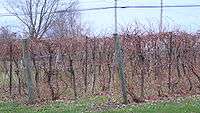Baco noir
| Baco noir | |
|---|---|
| Grape (Vitis) | |
|
Baco Noir vines before budding (November 2006 in Nova Scotia). | |
| Colour of berry skin | noir |
| Also called | Baco 1, Baco N°1, Baco #1, Bacoi, Bago, Bakon, Bako Speiskii |
| Notable regions | Ontario, New York, Michigan, Mississippi, Wisconsin, Pennsylvania, Oregon, New Mexico |
| Wine characteristics | |
| General | Medium body, deeply tinted |
Baco noir (pronounced BA-koh NWAHR) is a hybrid red wine grape variety produced by Francois Baco from a cross of Vitis vinifera var. Folle blanche, a French wine grape, and an unknown variety of Vitis riparia indigenous to North America.[1]
Regions
In 1951 the variety was brought to the cooler viticulture regions of North America, such as British Columbia, Ontario, Nova Scotia, New York, Michigan, Mississippi, Wisconsin, Pennsylvania and Oregon. In 1955 the variety was brought back to Canada, where the "George" clonal variety is commonly used. Baco noir was the target of a vine-pull program in Canada in the early 1980s, which means that there are few older plots of this varietal left in Canada.
Oregon's first Baco Noir vines were imported by Philippe Girardet in 1971 for his winery located in the Umpqua Valley.
This variety is also grown in certain parts of Colorado as vineyard area expands beyond the traditional AVA's of Colorado and across the Front Range.
See also
- Baco 22A (Baco blanc)
References
- ↑ "One of Oregon's best reds? Baco noir". Oregonian. May 31, 2009. Retrieved 2015-09-11.
